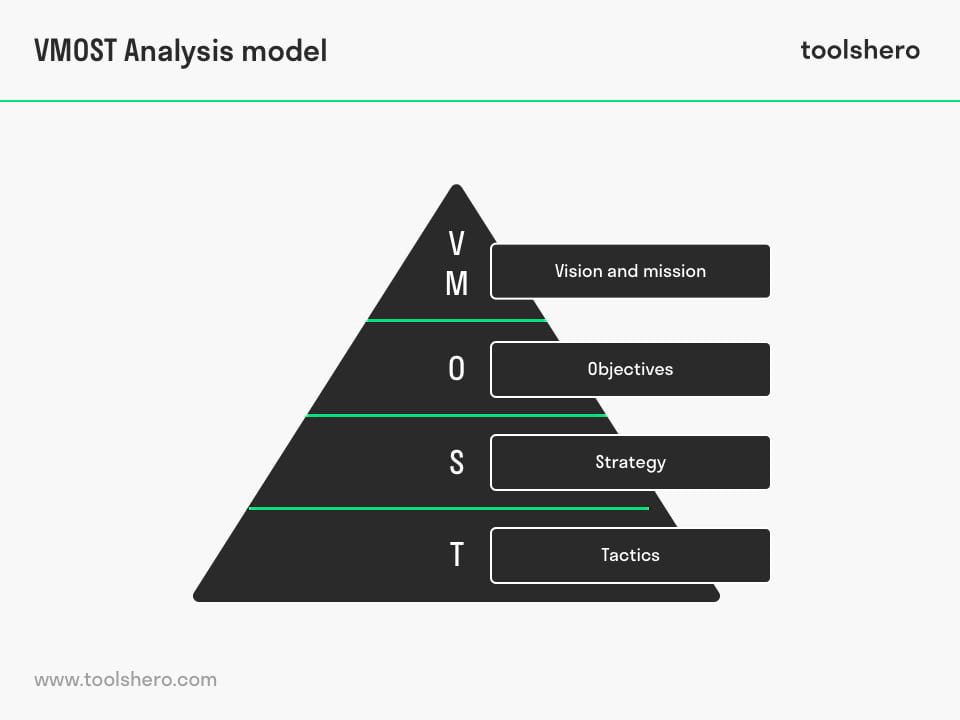VMOST Analysis (Sondhi) explained

VMOST Analysis: this article explains the theory of the VMOST Analysis, developed by Rakesh Sondhi in a practical way. In addition to what it is, this article also highlights the 5 elements of the model, its effectiveness and a brief summary. After reading you will understand the basics of this strategy and change management tool. Enjoy reading!
What is a VMOST Analysis?
The VMOST Analysis, also known as the MOST Analysis, is a framework and evaluation technique for strategic planning in an organisation. This type of Analysis ensures stakeholders in an organisation gain reliable insight into the desired changes in their organisation.
After carefully performing this analysis, it will present various options on how to bring about change while keeping sight of the strategic and long term vision of the organisation.
The VMOST Analysis framework connects both the vision and tactics to pursue this vision. VMOST is an acronym and means Vision (V), Mission statement (M) elements and the components: Objectives, Strategies and Tactics.
For example, the analysis may increase the effectiveness of investments in a company by stimulating how value is added to help a company move forward in the right direction. The main benefit of this structured method is that it enables team members to set goals at every level of the organisation. As the analysis works top down, it ensures that the focus remains on the most important goals.
The VMOST Analysis was devised by Rakesh Sondhi, Professor of Global Strategy at Hult International Business School, and published in his book Total Strategy (1999).
VMOST Analysis: 5 elements
Many employees generally tend to focus on the daily activities and vision of a company. They often forget to follow the course the company initially had in mind.
As a result, the strategies, goals and tactics become redundant, as do the mission statement and vision.
The greatest danger is that goals and desired results are not achieved, even while employees try hard to achieve them. For these reasons, an organisation needs a clear strategy in which all the components and relevant aspects of the company are combined.
The following components, which can be expanded upon if necessary, come together in the VMOST Analysis:

Figure 1 – Components of the VMOST Analysis
Vision
The set of ideas that describes what the future should look like is called a vision. As it concerns the future, vision statements often use terms like ‘will’ or ‘shall’ and will often contain visual descriptions such as a location where the plans should be implemented.
In addition, the vision also often contains an idea on how and which products should be offered. A good vision has a long-term character, though due to the high level of dynamics in organisational life, these might need to be changed along the way.
A Big Hairy Audacious Goal (BGAG) is ambitious and can therefore be incorporated in the vision.
Mission
Once the vision has been created, mission statements are concise actions of changes to help the company accomplish its vision.
Missions are action-oriented and contain specific, feasible plans, often at a high level. Depending on the vision, one or more mission statements might be needed to help the company get to where it wants to be, and these may take weeks, months and sometimes even years.
Similar to a mission in military context, mission statements often require multiple people to achieve the goal in question.
The same applies in the corporate world. Therefore, it is often a complicated task, in which planning and resource management are combined at the very least, to form missions and incorporate them in the vision.
Objectives
After the missions have been established, goals are linked to them, in order to help the user measure their success rate. Goals are checkpoints that let the user know whether an individual mission statement has been completed or not.
Measuring success is often done with Key Performance Indicators (KPIs). The SMART Goals acronym is a convenient tool to formulate realistic objectives.
If a goal has been defined in a SMART way, this means that it is specific, measurable, achievable, relevant and time bound.
Strategy
To achieve one’s goals, a strategy must be linked to a least one mission statement goal.
A consequence of this is that a strategy often results in being a complicated and comprehensive idea about how a company should be managed. Often a strategy supersedes a theme, for example the focus on new innovations or the improvement of user-friendliness of devices or apps.
Tactics
Tactics are actions that need to be completed in order to fulfil the strategy. Every strategy contains a number of tactics that can be carried out by various business units.
The easiest way to think about tactics is the use of the ‘Verb-Noun’ format. For example: design CRM, expand website or recruit employees. Tactics encompass multiple units and therefore are often part of multiple groups such as product, human resources, processes, technology or marketing.
What makes VMOST analysis effective?
According to Sondhi, the VMOST Analysis method is most suitable to guarantee the consistency of the strategy of the various components.
Aligning the strategy with the various aforementioned elements enables the user to determine whether the strategy is logical and effective and to reach the desired goals.
In Sondhi’s original concept, the VMOST Analysis is performed after determining the organisational environment, using the PESTEL Analysis and the techniques of Porter’s Diamond Model and Five Forces model.
In addition to these tools, the SWOT Analysis can also be used to determine the organisation’s options. Subsequently, the result of these techniques can be used to determine whether the current strategy fits the present situation of the organisation.
However, the use of the VMOST Analysis has expanded significantly since the original concept was published. The most important reasons for this are:
- Defining a framework for future strategies
- Creating a framework to evaluate future strategies to supplement the current strategy
- Evaluating the sub-organisational units such as departments, teams and even individuals
- Personal growth and career planning
Business analysts recognise the particularly high level of applicability of the VMOST Analysis in projects.
The VMOST structure can be applied to a programme or project in order to help define the project’s mission statement, goals and strategy and tactics required to achieve these goals. The primary goal of all these applications is to align the various components or elements in a company.
VMOST Analysis summary
A VMOST Analysis is a highly structured, yet simple and effective method to set goals for team members at every level of the organisation.
It ensures a high level of conformity among team members, which in turn will benefit company results. Usually the analysis is carried out to examine an organisation or unit’s current strategy, though the VMOST structure can also be used to define current and future strategies, projects, programs and even individualistic goals.
Now it’s your turn
What do you think? Does the VMOST Analysis explanation sound familiar? Do you recognise the different elements in your own work environment or do you have any other ideas? At the same time, are there any suggestions you would like to share in terms of balancing the various business units?
Share your experience and knowledge in the comments box below.
More information
- BAD Toolkit Ltd. (n.d.). VMOST: Simple yet powerful agile strategy tool. Retrieved from https://bad.tools/vmost/
- Sondhi, R. (1999). Total Strategy. Airworthy.
- Kaplan, R. S., & Norton, D. P. (2001). The strategy-focused organization. Strategy and Leadership, 29(3), 41-42.
How to cite this article:
Janse, B. (2018). VMOST Analysis (Sondhi). Retrieved [insert date] from Toolshero: https://www.toolshero.com/strategy/vmost-analysis/
Published on: 03/14/2018 | Last update: 09/07/2023
Add a link to this page on your website:
<a href=”https://www.toolshero.com/strategy/vmost-analysis/”>Toolshero: VMOST Analysis (Sondhi)</a>













3 responses to “VMOST Analysis (Sondhi) explained”
This seems just to be a variation of Hoshin Kanri really, which was in place before in big Japanese Lean companies.
Thank you for your comment, Al.
Thank you for this article, clearly written and easy to follow. I often find the Vision and Mission parts to be slightly overlapping or even confusing. It would cdrtainly help I think to present an example for each category, perhaps like Sinek does for the Why model?